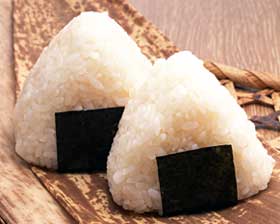
[Update:] Be sure to check out my easier, neater way to make onigiri!
Onigiri are rice balls, usually with a tasty filling. They are very portable, and therefore are very popular for carry-along lunches. Part of their appeal lies in the fact that if you're Japanese, you just love the taste of rice. It's genetic. [Edit: another word for onigiri is omusubi. I guess it just depends on what word you grew up with. In our house it was always onigiri.]
Onigiri can stand on their own, or be part of a bento or boxed lunch. (For some reason it's never just called "nigiri", though bento is also called obento, which is the honorific term.) Onigiri are also a great make-ahead snack for a crowd, since with the appropriate fillings they keep rather well. I remember my aunt making 12-cups of rice worth of onigiri at a time for the large family gatherings at New Year's or Obon (August festival to pay respect to our ancestors). Her hands would be bright red from the heat of the rice. She favored salted salmon (shio zake) as the filling usually - very salty salmon in fact.
Onigiri is also one of my top comfort foods. It reminds me of the ones my mother used to make for me for school outings (ensoku) as well as countless school lunches. When we stayed at my grandmother's and my cousines and I would take trips to the Chichibu mountain area, my aunt would make huge rice balls to assuage our appetites. There's a comforting feeling of continuity with history too, because Japanese travelers have sustained themselves on those salty rice balls for hundreds of years.
Like obento boxed lunches, onigiri can be elaborate creations, but the simple versions the are best in my opinion. We often bring some onigiri with us on long train trips: it's a lot better than buying the overpriced sandwich buns from the vending carts. Yes, sometimes people look at us curiously as we bite into those soccer-ball colored balls. We don't care one bit.
While I was working on writing up this entry, I came across this post by Mimi Ito . Japanese people have a lot of emotional attachment to obento, and to onigiri too.
Filed under:
basics japanese rice onigiri omusubi